| section Home
Production, Amateur Radio amateur Model aircraft, rocket- Useful, entertaining |
Stealth master
Electronics Physics Technologies invention |
space Mystery
Earth Mysteries Secrets of the Ocean Stealth section Map |
|
| Use of material is permitted for reference (for websites - hyperlinks) | |||
Navigation: => |
Home / Products Patents / In the section of the catalog / back / |
|
INVENTION
Russian Federation Patent RU2286251
![]()
METHOD bending plasterboard panels and structural elements produced by this process
Name of the inventor: Serafini Livio (IT)
The name of the patentee: EUROSISTEMI ITALIA SRL (IT)
Address for correspondence: 129010, Moscow, ul. Boris Spassky, 25, p.3, Ltd. "Gorodissky and Partners", pat.pov. GB Egorova
Starting date of the patent: 2002.05.22
The invention relates to a method of mass production of curved construction elements which are intended for finishing masonry or other structures and prepared from conventional plasterboard panels, which are already widely used in the field of construction. The technical result - the ability to easily construct buildings at low cost of labor and without special skills handmade with curved surfaces, which are carried out fully prepared, because they are formed by the installation of prefabricated elements on the spot and the same finishing them as required by conventional plasterboard panels. Plasterboard panels (A, B), formed by layers of a building cardboard located between the sheet of plaster and layers of paperboard with interposed therebetween a sheet of plaster, is clamped between the female part or half (C) of the mold and the male part or a half (D) press -form molding press, after which the layers in the paperboard coated vinyl adhesive or other suitable water-based adhesive. In each of the two panels making radial fractures in the plaster sheet is stretched and the outside layer of paperboard by bending the arc is compressed and the inside layer. Bonding of the first layer of paperboard panels (A) to the second layer of paperboard panels (B) enters a state of two panels of stable equilibrium constant respective opposite bending stresses.
DESCRIPTION OF THE INVENTION
The present invention relates to a method for mass production of curved construction elements which are intended for finishing masonry or other structures and prepared from conventional commercially produced flat plasterboard panels, which are already widely used in the field of construction for a variety of applications because, in addition to providing good thermal insulation and sound insulation, they have a good structural strength and are particularly suitable for finishing by simply painting or other surface treatment or coating.
Plasterboard panels to which the invention relates, the panels are the most common type, consisting of a sheet or plate of plaster, is sandwiched between two layers of paperboard.
Currently such panels can be used not only in the original flat shape but also as a profiled construction elements, which are obtained by the process described in Italian patent application MI 96 A 001586, and provides for bonding to one another by means of adhesives two plasterboard panels or two parts of one and the same folded panel, in which the previously performed multiple cuts and / or wedge-shaped incisions formed in the cardboard, which is located on the joined surfaces, and a layer of plaster in order to allow folding of intact wallboard to outer surfaces of said compounds like hinge constructions have each of said cuts or notches.
However, as is well known in the field of construction, this method does not allow to produce curved surfaces, for which still require concreting or pouring plaster in appropriate formwork or the use of elements produced on site with plywood, hardboard or other flexible material.
The method according to the invention is the result of solving the problem of workers employed in the construction field or in the field of interior decoration, possible to easily erect a building in particular, at low labor costs and without special manual work skills, curved surfaces that are performed entirely ready, because they are formed by the installation of prefabricated elements on the spot and the same finishing them as required by conventional plasterboard panels.
In general, the method according to the invention is as simple as it is new and has inventive step and is simultaneously bending and connecting a respective forming presses, two or more plasterboard panels superimposed on one another after adequate administration of their surfaces in contact with a suitable adhesive, which preferably is water-based impregnation to more effectively mitigate the layers and construction of cardboard to be bonded in a curved configuration.
For a better understanding of the novel method and structural elements produced in this way, it is illustrated in the accompanying non-limiting example in the drawings, in which:
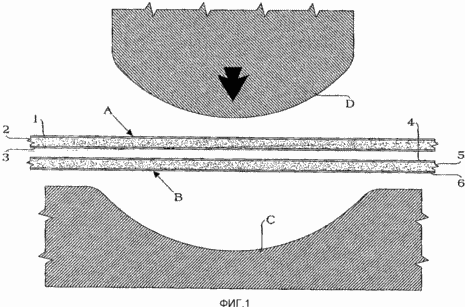
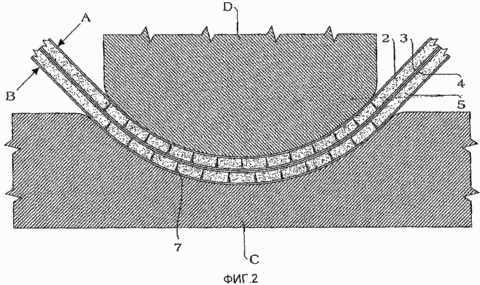
1 and 2 - shows schematically the method according to the invention by a cross-sectional image - with the forming press - two plasterboard panels before gluing them and imparting a curved configuration after such bonding.
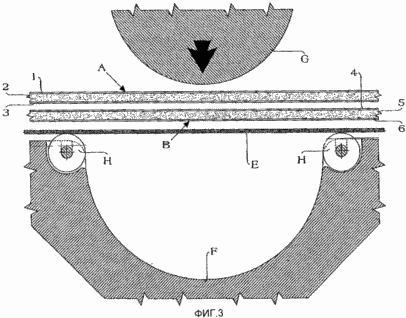

3 and 4 - by means of partial sections forming press before gluing the two curved panels, and after such a bonding illustrated extra arrangements for the case in which the need for more steep, ie having a smaller radius curves.
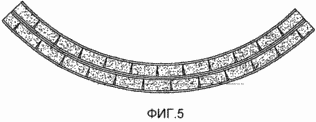 |
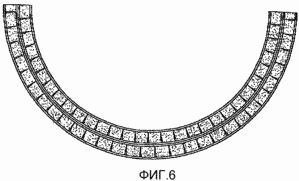 |
5 - cross section of the curved element of the building structure manufactured by press molding, as shown in Figures 1 and 2.
6 - cross section of the curved element of the building structure manufactured by press molding, as shown in FIG. 3 and 4.
 |
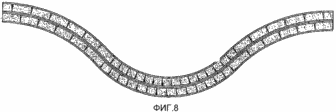 |
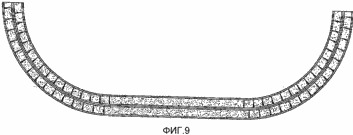 | |
7, 8 and 9 - additional specific embodiments of construction elements which can be manufactured the method according to the invention.
Plasterboard panels A and B, which are shown in cross section in Figure 1 are formed respectively layers 1 and 3 with a paperboard sheet disposed therebetween plaster 2 and layers 4 and 6 and with a paperboard sheet disposed therebetween plaster 5, wherein the front clamping of said panels between the female part of the mold C and D male part of the mold press forming is applied to them, vinyl adhesive or other suitable adhesive is water based and is applied to carry paperboard layers 3 or 4, i.e. on the contact surfaces of both panels joined by overlapping and compression.
Such deposition by impregnation processed layers paperboard and impart pliability facilitates their bending, while the sheets 2 and 5 plasters are rigid and they can generate a sequence of radial fractures 7 that are more or less close to each other, depending on the radius bending said sheets of thickness and consistent difference between the extreme inside and outside circumferences of each sheet.
Continued pressing of the two curved and superimposed panels A and B for the entire time required to evaporate the aqueous base and for the solidification of adhesive permanently stabilizes the bending press to shape. This is because in each of the joined together panels of gypsum plaster sheet undergoes radial tears, while paperboard layer outside of the curve is stretched and the layer of compressed inside curve. Therefore, bonding layer 3 paperboard panel A to layer 4 wallboard panel in the permanent forces, a stable equilibrium respective opposite bending stresses, ie, tension compression layer 3 paperboard and tension stretching layer 4 paperboard.
The residence time in pairs of curved panels inside the forming press can be considerably reduced and construction - considerably accelerated by coating the bonding surface of the tape or strip vinyl water-based glue, interspersed with strips or bands hot melt adhesive, such as self-hardening urea in aqueous solution, which hardens faster than vinyl adhesive.
Figures 3 and 4 show that if the curvature, introduced by the female part of the mold F and G of the male part of the mold press forming is significant or appreciable, panels A and B, both bendable and glued, after application of suitable adhesives the mating surfaces 3 and 4 are provided in the transverse direction - along their extension and during their introduction into the molding press - a flexible metal sheet E, which by the arrangement such that it is externally formed by a curved surface, and in a particular case - in contact with paperboard layer 6 panel B, ensures perfect bending panels and substantially uniform distribution of the radial fractures in the sheets 2 and 5 plaster.
In carrying out the described method can provide extra technological advantage, especially in cases where the curvature is significant or noticeable by a plurality of free rollers H which, being located at the boundaries of the mold cavity so that their axes are parallel to the generatrix of the curve is converted into rolling friction the friction which is created a flexible metal sheet E or, if said metal sheet is absent, plasterboard panels a and B alone when the assembly under pressure, or half of the male part of the mold G forcibly pressed into the male part or half press F shaped profile with the formation imparted in the form of press.
Although the specific examples illustrated embodiment shown with reference to the production of curved elements by joining two plasterboard panels by compression, this does not preclude a connection of two panels and to meet increasing demands for insulation, mechanical strength or other requirements.
In connection with the obtained profiles or shapes it should be noted that the developed method, being compatible with conventional requirements for forming a compressed structure, may provide the greatest freedom of choice of radii and extent of the curves (Figures 5 and 6) in the sequence of curves and counter-curves (Fig. 7 and 8), and in conjunction with other parts of the curved, rectilinear portions (Figure 9).
Obviously, without modifying the basic features of which are illustrated and described above, can be made in the method of the invention and the elements obtained by means of it, additional modifications and variations which are in any case within the scope of the appended claims. Description of the Italian patent application number the FO 2001 A 000015, which is the basis on which priority is claimed for this application, given herein by reference.
CLAIM
1. A process for bendings plasterboard panels, mainly comprising the steps of simultaneously bending and connection is carried out by compression molding presses in the respective two or more overlapping gypsum panels, each of which is formed by a sheet of plaster sandwiched between two layers of paperboard after prior application of a suitable adhesive, which preferably is water-based impregnation to more effectively mitigate and paperboard layers to be bonding and pairing in the bent configuration.
2. A method for bending according to claim 1, wherein the step of applying adhesive to the water-based impregnating includes layers of paperboard which are subject to gluing, to impart pliability, and ease of bending them, wherein the step of bending the sheets to adjacent plaster which are rigid, it includes generating a sequence of radial fractures which extend outwardly from the curve at intervals that vary depending on a predetermined bending radius and a plate thickness of plaster.
3. A method according to any bending of the preceding claims, characterized in that the pressing step, conducted for plasterboard panels subject to bending and connection configuration providing overlay is carried out for the time necessary to evaporate water base glue and curing, and includes self stabilizing the bend introduced by the form of press, due to the impact of the strain on the layers of paperboard every plasterboard panels, and this deformation is a deformation of stretching a layer on the outside of the curve, and compressive strain for the layer on the inside of the curve, in order to achieve a permanent stable equilibrium opposite bending stresses both layers paperboard that belong to different panels and are directly exposed to the influence of bonding.
4. A method for bending according to claim 2, wherein the step of applying to the plasterboard panels to be joined in a curved configuration comprises applying a vinyl adhesive or other suitable adhesive to the water-based.
5. A method for bending according to claim 3, characterized in that the residence time steam curved panels inside the forming press during the pressing step greatly reduces the expense of the additional step of coating, comprising applying to the surface to be bonded bands or strips of vinyl water-based glue, alternating with bands or stripes of melting glue, such as self-hardening urea in aqueous solution, which has a solidification time lower than the vinyl adhesive.
6. A method for bending according to claim 3, characterized in that to ensure a uniform and accurate bending joined gypsum panels and a substantially uniform distribution of the radial fractures in the plaster sheets available in the panels, the bending step further comprises during insertion panels between the female mold part and the male part of the mold press forming arrangement in the transverse direction along flexible sheet metal panels arranged in such a way that it is outside of the curve formed by the plasterboard panels.
7. A method for bending according to claim 6, characterized in that it further includes the step of setting a plurality of free rollers located at the boundaries of the female cavity half of the mold, which axes are parallel to the generatrix of the curve mold half and which is converted into rolling friction any friction with the flexible metal sheet E or plasterboard panels a and B alone, resulting from pressure on the assembly of the panels under the influence of the male part or half G mold to forcibly pressed into half F mold to form a profile, imparted in the form of press.
8. plasterboard panel curved method of any of claims 1-7.
9. The plasterboard panels of claim 8, characterized in that it consists of a curved construction elements made by compression bonding of two or more superimposed plasterboard panels (A, B), each of which comprises at least one list (2, 5) of plaster sandwiched between two layers (1, 3, 4, 6) of the building board having curved portions of the profiles of different shapes, and the sheets (2, 5) plasters comprise a sequence of radial fractures which extend outwardly from the arc bending the sheets and are arranged at intervals that vary depending on the thickness and bending radius sheets (2, 5) of plaster.
print version
Publication date 21.01.2007gg





Comments
Commenting, keep in mind that the content and the tone of your messages can hurt the feelings of real people, show respect and tolerance to his interlocutors, even if you do not share their opinion, your behavior in terms of freedom of speech and anonymity offered by the Internet, is changing not only virtual, but real world. All comments are hidden from the index, spam control.